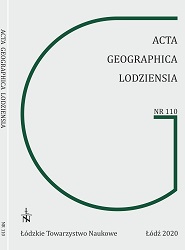LITHOLOGY AND GEOCHEMISTRY OF THE LATE GLACIAL AND HOLOCENE SEDIMENTS FROM GOSTYŃ LAKE (WESTERN POMERANIA, MYŚLIBÓRZ LAKELAND)
LITHOLOGY AND GEOCHEMISTRY OF THE LATE GLACIAL AND HOLOCENE SEDIMENTS FROM GOSTYŃ LAKE (WESTERN POMERANIA, MYŚLIBÓRZ LAKELAND)
Author(s): Andrzej Korzeniowski, Daniel Okupny, Adam Michczyński, Joanna Sławińska, Ryszard Krzysztof BorówkaSubject(s): Archaeology, Physical Geopgraphy
Published by: Łódzkie Towarzystwo Naukowe
Keywords: lakes; biogenic deposits; geochemistry; human impact; Holocene; western Poland;
Summary/Abstract: Sediment geochemistry and lithology were studied in Gostyń Lake in the eastern part of the Myślibórz Lakeland (part of the Western Pomeranian Lake District). The research was undertaken because relatively shallow lake basins without ground supply contribute to the intensification of water circulation through evaporation. Late Glacial and Holocene phases in the evolution of Gostyń Lake were reconstructed based on selected geochemical indicators (Fe/Mn, S/Fe, Na/K, Mg/Ca, Cu/Zn, Na+K+Mg/Ca, Fe/Ca) as well as on the presence of human activity (Stone Age, Bronze Age, Early Iron Age and Roman Period). Also, the geochemical and archaeological data were correlated. Generally, the lithogeochemical composition variability in the Gostyń Lake deposits was found to be controlled by changes in: 1) the climate, related to the biogenic accumulation environment, 2) land cover in the Late Glacial and Holocene, and 3) human activities. Principal Component Analysis (PCA) revealed four major variable groups responsible for the changes: hydroclimatic variations which determined the type of sedimentary conditions during the Holocene climate optimum; changes in the organic matter provenance (along with conditions favouring sulphide precipitation); and denudation processes in the Gostyń Lake catchment. The methods used allowed the distribution of ancient settlement to be traced. Interpretation of the geochemical indicators (Fe/Mn, Cu/Zn, S/Fe, Ca/Fe) should involve many more factors which, in the relevant literature, are treated as measures of changes in redox conditions.
Journal: Acta Geographica Lodziensia
- Issue Year: 2020
- Issue No: 110
- Page Range: 149-168
- Page Count: 20
- Language: English

